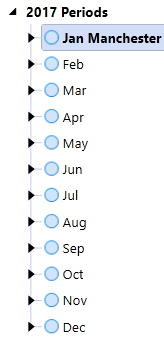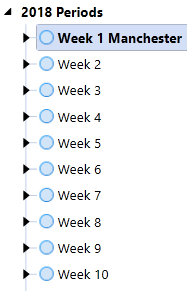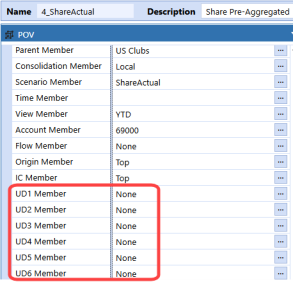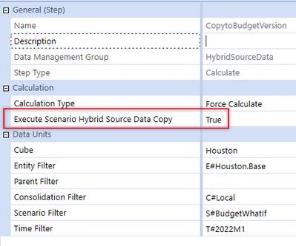Scenario Dimension
Scenario types offer great flexibility and the following 24 pre-set types are provided in each cube. Each type contains an unlimited number of scenarios. Dimensions are assigned to cubes and can differ by scenario type. You can show scenarios as a part of a hierarchy for organizational purposes. They do not consolidate.
-
Actual
-
Administration
-
Budget
-
Control
-
Flash
-
Forecast
-
FXModel
-
History
-
LongTerm
-
Model
-
Operational
-
Plan
-
Sustainability
-
Target
-
Tax
-
Variance
-
ScenarioType1-8
Security
These groups grant members access and rights to a scenario:
-
Read Data Group: Can view data.
-
Read and Write Data Group: Can view and modify data.
-
Calculate from Grids Group: Can calculate, translate, and consolidate from a cube view or form.
-
Manage Data Group: Membership in this group is required to run Data Management steps such as custom calculate or reset scenario. This prevents unauthorized users from launching steps which could alter or clear data unintentionally.
Workflow
Under Scenario, you can use the following properties to control the type of periods displayed to end users when they load data.
Use in Workflow
Set to False to omit the Scenario from the workflow view in OnePlace, making it unavailable to users setting the workflow point of view. To display the scenario, set this field to True.
NOTE: Data can still be entered with forms and the Excel Add-In to a hidden scenario.
Workflow Tracking Frequency
This determines how time displays in the workflow and is based on the type of data being entered for the scenario. See "Input Frequency" below for details about how these properties work together.
All Time Periods
This is the standard setting, which displays all periods in the year. A period could be months or weeks depending on the application. Once defined, you cannot change this setting.
Monthly
Use to set the workflow periods to monthly, which could be 12 to 16 months depending on the application. Once defined, you cannot change this setting.
Quarterly
Use to set the workflow periods to four periods, such as Q1, Q2, Q3, Q4. Once defined, you cannot change this setting.
Half Yearly
Use to set the workflow periods to two periods, such as H1, H2. Once defined, you cannot change this setting.
Yearly
This sets the workflow periods to one period, such as 2021. Once defined, this setting cannot be changed.
Range
Allows an Administrator to define a custom range that is displayed as one-time period including the start and end time. As data loads, each period displays, such as 11 – Jan and 11 – Dec. Once defined, this setting cannot be changed. The next set of properties only become available when the Range option is chosen.
NOTE: Workflow Tracking Frequency settings cannot be changed if the scenario is used in a workflow.
Workflow Time
To define the workflow time, click the ellipsis to the right and choose a time. Year or year and month can be defined.
Workflow Start Time
To define the workflow start time, click the ellipsis to the far right and choose a time. Year or year and month can be defined.
Workflow End Time
To define the workflow end time, click the ellipsis to the right and choose a time. Year or Year and Month can be defined.
Number of No Input Periods Per Workflow Unit
Use this free form option to enter a numerical value for the number of periods to be "no input" such as: 1,2,3,5. This disables input from the Import, Form, and Adjustment Origin Members for the specified periods. For example, if the first three months of data is automatically copied from Actual to Forecast with a user inputting the remaining nine months, enter 3 to make those periods read-only and prevent data entry.
Settings
Scenario Type
This property groups similar scenario types in order to share settings or Business Rules. A scenario type can contain many scenarios.
Input Frequency (Vary By Year)
This is the data frequency for the scenario. The current selections are Weekly, Monthly, Quarterly, Half Yearly, and Yearly. To vary this by year, click the ellipsis, choose the year, and make your selection. If the Quarterly or Yearly Frequency is used, data is not saved at a base (monthly/weekly) level as this would display invalid cells.
NOTE: The Input Frequency property with the Workflow Tracking Frequency property. For example, if the Input Frequency in 2017 is Monthly and the Workflow Tracking Frequency is All Time Periods, the workflow displays the following for this scenario in 2017:

If the Input Frequency varies by year, the Workflow Tracking Frequency updates the workflow view accordingly. For example, if the Input Frequency is Weekly in 2018, the Workflow Tracking Frequency still displays All Time Periods as shown:

Use Input Frequency Data in Lower Frequencies
Use to display data from the scenario's input frequency when processing a lower level invalid frequency. For example, in a quarterly scenario, display the amount from Q1 in M1, M2, M3 and in all weeks below these 3 months. In a yearly scenario, display the single yearly amount in all time periods in the year.
Default View
This is the standard default view for calculations, member formulas, and clearing calculated data. The current selections are YTD and Periodic.
Retain Next Period Data Using Default View
The scenario's Default View is either Periodic or YTD. Set to True if a Flow account has a data value in a future period (for example, Feb) and the data is being changed in a prior period (for example, Jan). Either the Periodic or the YTD amount for Feb must be changed to be consistent with the new Jan entry. If this setting is False, the Feb Periodic amount is retained if a Jan Periodic number is entered, or the Feb YTD amount is retained if a Jan YTD number is entered.
Input View For Adjustments
This is the standard view setting for entering data using a journal for the period. This setting is determined by how journals are entered, but typically uses the same view as the Default View setting. Current selections are YTD and Periodic.
NOTE: Regardless of the setting, all journals, except auto-reversing,must be entered monthly.
Use Input View for Adj in Calculations
Set to True to have calculations use the setting in Input View for Adjustments as the view even if the calculation attempts to override the default scenario view.
Zero No Data
The following properties determine how to handle zero no data. Periodic places a 0 value in the period without data. YTD places a 0 value in the current YTD month, causing the period to negate values from prior months.
No Data Zero View For Adjustments
This is the standard setting for no data in journals for the period. Current selections are YTD and Periodic. Typically, this setting is the same as the Input View for Adjustments setting.
No Data Zero View For NonAdjustments
This is tied to the data load and is used when there is not data for the period. The current selections are YTD and Periodic.
Consolidation View
This is the standard setting for the view of the consolidation. The current selections are YTD and Periodic. Typically, the Periodic setting is used especially if work is completed by period. However, all numbers are stored as YTD. Select YTD to enhance consolidation performance. This property can be changed and will update for the next consolidation.
NOTE: If a Consolidation View is Periodic and no data is loaded to the IC accounts for a specific month, custom elimination rules are required in the FinanceFunctionType.ConsolidateElimination section of a business rule attached to the cube to calculate expected elimination results. This requires storaging the C#Share member, which impacts overall consolidation performance.
The YTD consolidated results related to Consolidation View property on a Scenario is set to Periodic and where the Percent Consolidation Relationship Properties of Entities vary by time period, also known as “Org by Period.”
When the Consolidation Algorithm Type property on a cube is "Standard,” Scenario Consolidation View property of Period and Org by Period Entity Relationship Properties, the Share Consolidation member is consistently displayed for both YTD and Periodic on reports.
When the Consolidation Algorithm Type property on a Cube is set to "Standard with Stored Share," Scenario Consolidation View property of Period, and Org by Period Entity Relationship Properties, when a time period's Percent Consolidation changes to 0.0 when varying over time, the system now displays stored calculated results rather than derived.
NOTE: that the best practice for this type of “Org by Period” design typically drives a financial model design where the Consolidation Algorithm Type is set to “Custom.” In rare cases, this Cube setting is set as Standard and even more rare, this is set as Standard with Stored Share. In both rare situations, this Share Member view will have changed.
Formula
This is the ability to use a formula to execute copying between Scenarios prior to the consolidation of a Scenario. See Formula Guide About the Financial Model for more details.
Formula for Calculation Drill Down
This enables drill down on members with attached formulas. A specific formula for drill down is needed to display the original formula and the members that activate the drill down to the original values. You can drill down on calculated data cells and data cells copied via a Copy Data Management Sequence.
See "Formulas for Calculation Drill Down" in About the Financial Model for more information.
Clear Calculated Data During Calc
If True, existing data is cleared during the calculation process. If False, data can be cleared manually. The default setting is True.
Allow Input Into the Aggregated Consolidation Member
If True, allows you to submit data for base member values through the aggregated member. The default setting is False.
FX Rates
Use Cube FX Settings
If True, the rate type that is the default for the current cube is used. If False, custom rate calculations are required. Rate Type for Revenues and Expenses & Rate Type for Assets and Liabilities.
Average Rate
The average currency rate of a period from the first day to the last day of the month.
Opening Rate
The currency rate at the beginning of the period.
Closing Rate
The currency exchange rate at the end of a period.
Historical Rate
The currency rate to use for a particular historical Account calculation open so a special transaction can be valued on a specific date. Rule Type for Revenues and Expenses & Rule Type for Assets and Liabilities.
Direct
Calculation is direct with the current value and current rate.
Periodic
Calculation is weighted based on a period.
Constant Year for FX Rates
This setting is available when a scenario's Use Cube FX Settings is False. When set to False, this setting becomes a drop-down box displaying all available years. Once set, the rates for the selected year are used.
Hybrid Scenarios
For information about how the following properties impact hybrid scenarios queries and using hybrid scenarios, see Working With Hybrid Scenarios
Data Binding Type
Indicates the type of data binding that should occur for the target scenario. Choose an option:
-
Share Data from Source Scenario: shares a read-only cube data set from the source Scenario to the target Scenario.
-
Copy Input Data from Source Scenario: copies base level cube data from a source Scenario to the target Scenario.
-
Copy Input Data from Business Rule: copies base level cube data based on a Finance business rule.
Source Scenario or Business Rule
Enter the Source scenario member or business rule to indicate the source location.
End Year
This is the only property that controls Time. If a data query must end after a specific year, indicate that year here. For example, if it should not occur in 2021, the End Year is 2020 to exclude all future years from a query. To query all years, leave this field empty. All years containing data will be included in the results.
The database stores data records by year, each year having its own data table and containing the data records for each period. When data is queried using a Hybrid Scenario, it occurs at the database level, and only returns the periods containing data.
Member Filters
The members listed in a comma separated list are the only ones included in data query results. This can include multiple dimension types, member expansions, or single members. If this field is blank, all source data is included in query results.
Member Filters to Exclude
The members listed here in a comma separated list, are excluded from query results. This can include multiple dimension types, member expansions or single members. If this includes members from the Member Filters property, those members are excluded.
NOTE: You cannot use Data Unit dimensions in the Member Filters or Member Filters to Exclude properties (Entity, Time, Consolidation, Scenario).
Pre-aggregated Members
Use this property to share or copy data from a parent member (source) to a base member (target). For example, if you query the Top member of a large dimension such as a UD, the aggregated total is calculated "on the fly" each time.
If the detail of a dimension is not needed, set the top member to a Base member to pre-aggregate. This alleviates repetitive "on the fly" calculations for the same number.
UD1#Top=UD1#None,UD2#Top=UD2#None,UD3#Top=UD3#None,UD5#Top=UD5#None,UD5#Top=UD5#None, UD6#Top=UD6#None

NOTE: Ensure that the base members shown above are included in the Member Filters property and the parents are included in the Member Filters to Exclude property.
Options
Hybrid Source Data Options provide additional control when executing a hybrid share or copy. The settings are optional and will vary. Options are name-value pairs. Ensure that the option names, definitions and syntax are accurate and include any custom name-value pairs if a business rule is used to copy. Create a comma separated list if you use multiple options.
ExecuteCopyDuringCalc
A True / False property setting which is False by default. If True, Hybrid Source Data copy is executed during the Data Unit Calculation Sequence (DUCS). If False, the Hybrid Source Data copy will not run during the DUCS and a Calculate Data Management Step type is needed to execute the Hybrid Source Data copy. On the Data Management step, set Execute Scenario Hybrid Source Data Copy as True. The calculation defined on this Data Management step uses the settings from the Hybrid Source Data properties to run the copy.

This setting is helpful for versioning or seeding where constantly copying unchanging numbers adds unnecessary overhead to every calculation. This setting should be used with either of the Copy binding types and is not applicable with the Share binding type.
CopyAsDurableData
A True / False property setting which is False by default. If True, copied data has a Storage Type of "Calculation". Calculated data is cleared at the beginning of the DUCS (if the Scenario setting of Clear Calculated Data During Calc is True) and will re-calculate. If this setting is True, copied data has a Storage Type of "DurableCalculation". Durable data is not cleared at the beginning of DUCS (regardless of the Scenario setting for Clear Calculated Data During Calc) and must be cleared manually with a rule.
The ExecuteCopyDuringCalc and CopyAsDurableData settings are used together. Typically, if ExecuteCopyDuringCalc is True, CopyAsDurableData is False (and vice versa). Use this setting with either of the Copy binding types. It is not applicable with the Share binding type.
RemoveZeros
A True / False property setting that is False by default. If True, zeros are removed when copying data if all periods within the year of the intersection being copied are 0.
SourceTimePeriodForYearlyResult
This property setting is used when the data results only require data from a specific source Time member. Indicate the source Time Period. Define that time period here. For example:
SourceTimePeriodForYearlyResult=M6
The hybrid scenario’s Input Frequency must be Yearly, the only frequency that accepts a value from one period. The source scenario’s Input Frequency can be more granular such as Weekly or Monthly. If a source time period is not defined, the source Year value is used in the hybrid Year Value.
Examples include a weekly period (Wx), a monthly period (Mx), a quarterly period (Qx) or a half year period (Hx). You cannot specify a year. It will match the year between the source and target.
SourceViewForYearlyResult
This setting is used if the Input Frequency of the target scenario is Yearly and the source scenario has a more granular Input Frequency. This setting can be Periodic or YTD. YTD is the default. You can indicate if you want to copy / share the time period being copied / shared as a periodic or YTD value.
The SourceTimePeriodForYearlyResult and SourceViewForYearlyResult settings are used together.
Custom Settings
Text 1…Text 8
Enables you to user custom attributes for many purposes such as business rules, member filters or transformation rules. The value can be changed in the tag over time as the business changes, or by Scenario Type.